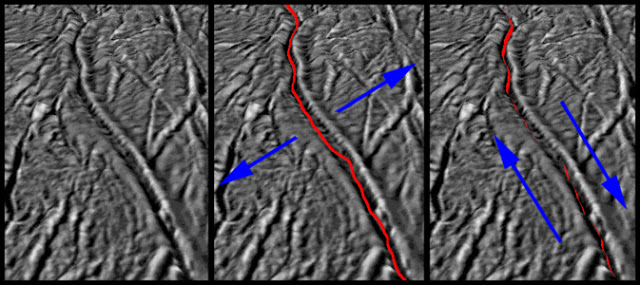NASA finding suggests that a large reservoir of liquid water – a global or local ocean – would be necessary to allow Enceladus to flex enough to generate stresses great enough to deform the surface, Hurford said. That process would control the timing of the jet eruptions. The finding also suggests that Saturn’s tides create an enormous amount of heat in the area.
These images, based on ones obtained by NASA’s Cassini spacecraft, show how the pull of Saturn’s gravity can deform the surface of Saturn’s moon Enceladus in the south polar region crisscrossed by fissures known as “tiger stripes.” Image credit: NASA/JPL-Caltech/SSI/
Images from NASA’s Cassini spacecraft have, for the first time, enabled scientists to correlate the spraying of jets of water vapor from fissures on Saturn’s moon Enceladus with the way Saturn’s gravity stretches and stresses the fissures. The result is among the Cassini findings presented today at the Lunar and Planetary Science Conference at The Woodlands, Texas.
“This new work gives scientists insight into the mechanics of these picturesque jets at Enceladus and shows that Saturn really stresses Enceladus,” said Terry Hurford, a Cassini associate based at NASA Goddard Space Flight Center in Greenbelt, Md.
Enceladus is unique in the Saturn system in having jets of water vapor and organic particles spray from long fissures in its south polar region. The long fissures have been nicknamed the “tiger stripes.”
Hurford and colleagues suggested a few years ago that tidal pulls from Saturn’s gravity could explain the existence of the jets, but they had not been able to correlate specific jets with calculated stresses until now. They studied the jets emerging from the warmest regions within the tiger stripes Baghdad Sulcus and Damascus Sulcus.
If you liked this article, please give it a quick review on ycombinator or StumbleUpon. Thanks

Brian Wang is a Futurist Thought Leader and a popular Science blogger with 1 million readers per month. His blog Nextbigfuture.com is ranked #1 Science News Blog. It covers many disruptive technology and trends including Space, Robotics, Artificial Intelligence, Medicine, Anti-aging Biotechnology, and Nanotechnology.
Known for identifying cutting edge technologies, he is currently a Co-Founder of a startup and fundraiser for high potential early-stage companies. He is the Head of Research for Allocations for deep technology investments and an Angel Investor at Space Angels.
A frequent speaker at corporations, he has been a TEDx speaker, a Singularity University speaker and guest at numerous interviews for radio and podcasts. He is open to public speaking and advising engagements.


